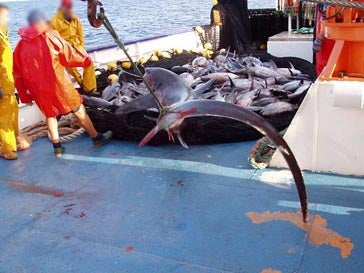Learn More: Shark Bycatch

Bycatch is a term used to refer to any species caught accidentally while fishing for other species. According to the FAO, there are few fisheries that don’t catch sharks as bycatch, and some fisheries actually catch more sharks than their targeted species. Estimates suggest tens of millions of sharks are caught as bycatch each year.
With the high demand for shark fins, sharks are no longer thrown overboard with a chance for survival, but finned first, thus blurring the line between targeted fisheries and bycatch. Some of the most troublesome fishing gears for sharks are longlines, trawls and gillnets.
Longline fishing uses thousands of baited hooks hanging from a single line, often miles long. Swordfish, tuna, mackerel and sharks are commonly targeted by these fisheries. Longlines catch a large amount of bycatch because the baited hooks provide an easy meal for any indiscriminant predator, including sharks. They are often set in the water for extended periods of time, and by the time they are removed from the water, the hooked sharks are often dead.
A trawl is a large net that is pulled through the water column or along the seabed. This fishing gear is typically used to catch fish or shrimp. Catching unwanted species, such as sharks, is a problem for trawlers because it is a very indiscriminant form of fishing. Trawling can occur with one boat pulling a net or cooperatively by two boats, each pulling an end of a much larger trawl net.
Gillnets are long walls of netting hung in the water to trap and hold fish. A fish swims into the invisible netting and as it swims in reverse to try to dislodge, its gills become caught in the net.
Sharks, like other fish, often become entangled in the netting even if they are not the targeted species. If the trapped sharks are still alive when the net is retrieved, they are often injured and stressed.

